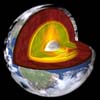| . |  |
. |
Heavy rainfall causes both higher surface erosion rate and upheaval of underlying bedrock in the Washington Cascades mountain range, according to a study published in the Dec. 11 issue of the journal Nature. The geological structure of the Cascade range may be governed by rainfall, sums up David Montgomery, University of Washington professor of Earth and space sciences and one of the co-authors. This data is the first convincing evidence for such effects on a mountain range scale over a period of millions of years. "People have long thought that the scale and pattern of rock uplift is mostly controlled by deep, plate-tectonic forces," says Peter Reiners, lead author, assistant professor at Yale and graduate of the UW. The pattern of rainfall may cause bedrock to be pulled up towards the Earth's surface faster in some places than others, he said. For example, rock uplift on the west flank where precipitation is high is three to 10 times faster than elsewhere in the range. The researchers used a low-temperature radioisotopic dating method that determines when and how fast erosion brings bedrock towards the surface of the Earth and correlated that with modern mean annual precipitation rates. The result was evidence to support long-standing theories about the interplay of climate, erosion, and tectonics. "Geologists usually think of erosion wearing away mountains," said David Fountain, program director with the National Science Foundation, which funded the research. "These results, however, show that erosion can be an important player in uplift of mountain ranges, especially in mountainous regions that receive heavy precipitation." The rainfall is heavy in parts of the Pacific Northwest because moist air moving east from the Pacific rises and cools as it encounters the ranges, dumping large amounts of rain and snow on the west side of the Cascades, where it rains about 10 times more than most places in Washington. The other co-authors are Todd Ehlers of the University of Michigan and Sara Mitchell, a UW graduate student now teaching at Carlton College. Related Links University of Washington SpaceDaily Search SpaceDaily Subscribe To SpaceDaily Express  Berkeley - Dec 17, 2003
Berkeley - Dec 17, 2003Radioactive potassium, common enough on Earth to make potassium-rich bananas one of the "hottest" foods around, appears also to be a substantial source of heat in the Earth's core, according to recent experiments by University of California, Berkeley, geophysicists.
|
| ||||||||||
| The content herein, unless otherwise known to be public domain, are Copyright 1995-2016 - Space Media Network. All websites are published in Australia and are solely subject to Australian law and governed by Fair Use principals for news reporting and research purposes. AFP, UPI and IANS news wire stories are copyright Agence France-Presse, United Press International and Indo-Asia News Service. ESA news reports are copyright European Space Agency. All NASA sourced material is public domain. Additional copyrights may apply in whole or part to other bona fide parties. Advertising does not imply endorsement, agreement or approval of any opinions, statements or information provided by Space Media Network on any Web page published or hosted by Space Media Network. Privacy Statement All images and articles appearing on Space Media Network have been edited or digitally altered in some way. Any requests to remove copyright material will be acted upon in a timely and appropriate manner. Any attempt to extort money from Space Media Network will be ignored and reported to Australian Law Enforcement Agencies as a potential case of financial fraud involving the use of a telephonic carriage device or postal service. |